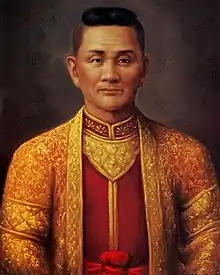Kawila
Kawila (Thai: กาวิละ, Northern Thai: ![]() , 1742–1816), also known as Phra Boromrachathibodi (Thai: พระบรมราชาธิบดี), was a Siamese nobleman of the Chet Ton Dynasty who ruled as king of Chiang Mai during the early Rattanakosin period. He is credited with rebuilding the population of the city of Chiang Mai after the long-running wars between Siam and Burma.
, 1742–1816), also known as Phra Boromrachathibodi (Thai: พระบรมราชาธิบดี), was a Siamese nobleman of the Chet Ton Dynasty who ruled as king of Chiang Mai during the early Rattanakosin period. He is credited with rebuilding the population of the city of Chiang Mai after the long-running wars between Siam and Burma.
| Kawila พระเจ้ากาวิละ | |
|---|---|
 Portrait of Kawila | |
| Ruler of Lampang | |
| Reign | 1774 - 1782 |
| Predecessor | Chaikaew |
| Successor | Khamsom |
| Ruler of Chiang Mai | |
| Reign | 1782 - 1816 |
| Predecessor | Bunma |
| Successor | Thammalangka |
| Born | 31 October 1742 |
| Died | unknown date in 1816 |
| House | Chet Ton Dynasty |
| Father | Prince Keaw |
| Mother | Princess Chantadevi |
Family
Kawila was born on 31 October 1742, the eldest of the ten children of Prince Kaew and Princess Chantadevi; seven of the ten were sons, collectively known as "the seven princes".[1] His father and grandfather had ruled Lampang Province.[2] Among his brothers were Thammalangka, who would later serve as Kawila's regent before succeeding him as king of Chiang Mai, and Khamfan, who would also go on to rule Chiang Mai.
Burmese-Siamese War
Kawila was one of a group of Lan Na nobles who rebelled against the Burmese in northern Thailand during the Burmese-Siamese War of 1775-6. In 1782, Kawila was appointed as the ruling king of 57 cities by Rama I of Thailand.[2]
Restoration of Chiang Mai

Among the cities under Kawila's rulership was Chiang Mai, which had been largely abandoned during the long-running wars between the Burmese and Siamese armies; nearly twenty years of being on the front lines of the conflict had taken a toll on both the city's population and infrastructure.[3] Kawila entered the city in 1796 with an elaborate ritual, involving entering the city through the Chang Phuek Gate after first sending through a Lau person leading a dog and carrying a rattan pack, then spending the night in front of Wat Chiang Man before entering the palace the next morning. This ritual was a replication of the one followed by King Mangrai, the city's founder, five centuries earlier in 1296.[2]
Kawila's rebuilding policy is sometimes translated as "Put vegetables into baskets, put people into towns." He sought out the former inhabitants of the city, who had fled to the nearby hills and mountains, and brought them back to the city.[4] When the surviving original inhabitants proved insufficient to repopulate the city, Kawila launched numerous campaigns into neighboring Shan states, capturing their people and resettling them in Chiang Mai.[5] The war captives brought to Chiang Mai included people from the Tai Yai, Tai Yong, Tai Khoen, and Lue ethnicities.[4] He also rebuilt many of the city's fortifications, in case of further war with Burma.[3]
As a trusted ally of the new Siamese monarchy, Kawila was largely left to govern his territories as he pleased. He promoted the revival of many traditional Lan Na cultural practices, including music, dance, literature and craftsmanship, as well as distinctive regional Buddhist ceremonies.[3]
Death and succession
Kawila died in 1816 and was succeeded as king of Chiang Mai by his brother Thammalangka. One of Kawila's children, Kawilorot Suriyawong would later reign as king of Chiang Mai.
References
- Penth, Hans, "A Brief History of Lanna: Northern Thailand Past to Present", pg. 64
- Champawan, Suwipa, and Akarachinores, Krirk, "Political Issues Hidden in the 19th Century Thai Chronicle", Chiang Mai University
- "Monuments, Sites and Cultural Landscape of Chiang Mai, Capital of Lanna", UNESCO
- Schliesinger, Joachim, "Thai Groups of Thailand, Vol. 1", pg. 70
- Grabowsky, Volker, "Forced Resettlement Campaigns in Northern Thailand During the Early Bangkok Period", Journal of the Siam Society 87.1 & 2 (1999)